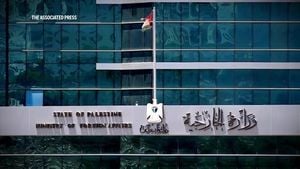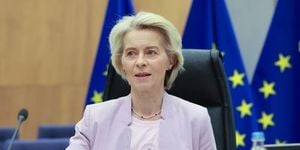As Kenya’s political landscape heats up ahead of the 2027 General Election, President William Ruto finds himself at the center of a fierce battle for the country’s most influential voting blocs. While the Rift Valley remains solidly in his corner, the once-reliable Mt Kenya region appears to be slipping through his fingers, forcing Ruto to recalibrate his strategy and confront a mounting rebellion that could determine his political future.
On April 2, 2025, President Ruto addressed residents at the bustling Kagio trading centre in Kirinyaga during his second day touring Mt Kenya. This was no ordinary visit—it was a calculated move to shore up support in a region that, just three years ago, handed him a decisive 87 percent of its votes, clinching his narrow victory over Raila Odinga. But as political analyst Herman Manyora told Daily Nation, “With the raging rebellion by the region’s voters—who in 2022 gave him 87 per cent of their votes, accounting for his narrow win against Raila Odinga—it appears he will have to sweat for support.”
Indeed, the challenges facing Ruto in Mt Kenya are as numerous as they are complex. The fallout began when he brought his former rival, Mr. Odinga, into government—a move widely seen as a snub to Mt Kenya’s political sensibilities. The subsequent impeachment of Deputy President Rigathi Gachagua in October 2024 only deepened the rift. According to Kirinyaga Woman Representative Njeri Maina and Mogotio MP Reuben Kiborek, the region now views Ruto as an outsider: “Mt Kenya is opposing Dr Ruto because he is not from their region,” Kiborek asserted.
Rather than personally engaging with the region as he once did, Ruto has delegated outreach to local loyalists, dividing his campaign into three teams led by Deputy President Kithure Kindiki, Laikipia East MP Mwangi Kiunjuri, and a cadre of civil servants deployed since August 16, 2025. But as political commentator Prof Peter Kagwanja warns, “All his loyalists are marked men, equally uncertain of their fates in the 2027 elections...It is a case of uncertain leaders campaigning for an uncertain President.”
Adding fuel to the fire are former insiders-turned-rivals like Gachagua, ex-Attorney-General Justin Muturi, and former Agriculture CS Mithika Linturi, whose insider knowledge makes their criticism especially potent. Prime Cabinet Secretary Musalia Mudavadi lamented, “Too many former state officers are betraying their oath of secrecy and revealing matters that should remain confidential.”
Hovering over the region’s politics is the enduring influence of former President Uhuru Kenyatta. Many Mt Kenya voters now believe Kenyatta was right to oppose Ruto in 2022, a sentiment that has united Odinga’s 2022 supporters with a swelling contingent of disillusioned Ruto voters. Political analyst Malila Munywoki notes, “Dr Ruto must build fresh ties with new players rather than appearing to court Mr Kenyatta, who remains part of his Mt Kenya problem.”
Complicating matters further is the perception that Ruto’s allies have resorted to “uncouth talk,” as described by New Gikuyu Embu Meru Association chairman Isaac Mungai. “The internet is awash with President Ruto’s allies insulting voters with vulgar and condescending remarks. This portrays the President as a villain willing to attack traditions, religion, and even matrimony just to prove power.” Nyeri Catholic Archbishop Anthony Muheria has repeatedly cautioned against this “reckless culture of empty talk instead of tackling real priorities.”
Underlying the political drama is the region’s deep-seated “Raila phobia.” According to political scientist Festus Wangwe, “When Ruto brought Odinga into government, Mt Kenya felt betrayed. He assumed too much knowledge of the region’s political passions and carried himself with overconfidence in an area that carried him to State House.”
Economic grievances are also front and center. For three years, President Ruto’s government has introduced new taxes that local business magnates claim have stifled investment and growth. Mr. Kanene Kabiru, director at Rwathia Distributors, explained, “It has now been three years of crying that President Ruto's regime has a wild appetite for taxes...Some of his taxes eat into investment capital, hence stifling stability and growth.” Kabiru added that austerity measures and mass layoffs have soured the business climate, fueling resentment across all levels of investment.
Promises of economic revival have also fallen short. On August 1, 2025, Information, Communication and the Digital Economy CS William Kabogo admitted in Murang’a, “Our biggest problem is unfulfilled promises. We told people there would be money in their pockets, but we are yet to deliver.” While Kabogo struck an optimistic note—likening the government to “a dairy cow dripping with milk”—Kikuyu Council of Elders Chairman Wachira Kiago dismissed this as “support-for-hire politics instead of long-term development.” Government Spokesman Isaac Mwaura acknowledged the unmet promises but insisted that President Ruto remains committed to fulfilling them.
Meanwhile, the government is accused of “spendthrift in scarcity”—relying on token gestures rather than substantive economic relief. Mt Kenya Indigenous Faiths Union Chairman Bishop Edward Nyutu criticized, “We have seen empowerment meetings where beneficiaries end up with only Sh64...Using money to mesmerise voters is outdated. People now ask: How much of that cash is really mine?”
Perhaps most fundamentally, Mt Kenya’s restlessness is rooted in its history of producing three presidents: Jomo Kenyatta, Mwai Kibaki, and Uhuru Kenyatta. Political pundits argue that the region may feel entitled to power, a sentiment former President Kenyatta articulated in 2022: “Mt Kenya is not the only region that can lead the country in rotation with the Rift Valley, hence my support for Mr Odinga.”
Yet while Mt Kenya simmers with discontent, the Rift Valley stands unwavering behind Ruto. On August 18, 2025, National Assembly Speaker Moses Wetang’ula rallied supporters at St Peter’s Catholic Church in Kapsabet, declaring, “As residents of Rift Valley, we are preaching to the converted. You do not need to be mobilised or coerced to support your son for a second term because you know the direction the country is taking.” Wetang’ula dismissed Ruto’s critics as “self-seeking characters without an agenda,” urging the President to “ignore such noises the way a cow ignores the croaking of frogs and continues to drink water.”
Wetang’ula highlighted Ruto’s progress in education, healthcare, roads, and economic stabilization, insisting that “when we speak to ordinary citizens, they encourage us and the President to continue improving their livelihoods. That is what matters to the people.”
Nandi Governor Stephen Sang echoed these sentiments, defending Ruto’s record: “People are unfairly asking why the President has not achieved in two years what Mr Uhuru Kenyatta or Mr Mwai Kibaki achieved in their ninth and tenth years in office. If you compare Dr Ruto’s two years with their first two years, you will find that he has exceeded expectations.” Sang argued that Ruto’s eligibility for a second term should be judged on his achievements, not on comparisons to past presidents’ later years.
As the opposition intensifies its campaign to unseat him in 2027, President Ruto faces a defining test: can he rebuild trust in Mt Kenya while maintaining his Rift Valley stronghold? For now, the answer remains uncertain—but one thing is clear: the road to re-election will be anything but smooth.




